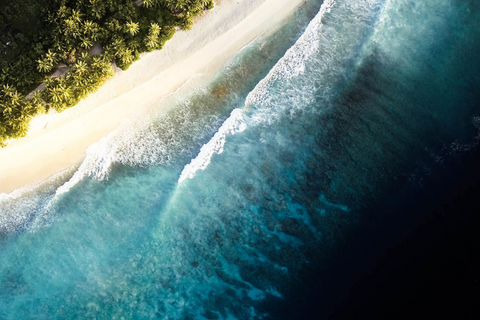Blue Philanthropy - The Need for Ocean-Focused Philanthropy
article • Investment Management

Prabhir Correa
2023-03-22 | 10 minutes
I was recently in Goa for a fundraising walk along one of the state’s many southern beaches. As the early morning Sun started to warm up the muggy air, I happened to come across a group of men dragging a traditional fishing dogger out from the ocean. Larger than a canoe, the wooden raft was barely big enough to fit four men, but once out of the water, it took a group of nearly ten to drag and push it onto the sandbar. Each of the men looked exhausted – which was no surprise given that they had probably spent the better part of the night out at sea – but what drew me to them was the look of dejection in their eyes. A quick chat revealed that the catch had been exceptionally bad. The men had pulled out more plastic than fish, and the few fish that they did manage to catch were significantly undersized. One of the veterans in the group, a man by the name of Pascal, picked up a small, palm-sized fish and pointed at its underbelly. “This is a shevtto, a local species. Notice the shape of the stomach area? This one is a mature male. Males are usually much larger. Selective fishing of the bigger specimens by industrial fishing trawlers is leading to smaller and smaller catch sizes every year”. Pascal then plucked out a broken plastic bottle from one of the nets and crushed it in his hand. “The sea and estuaries are full of this rubbish. The plastic breaks down and the fish swallows it. We often find pieces of plastic in our fish. Very soon our fish will have less meat and more plastic”.
Pascal’s predicament is not a unique one. Closer to home (Mumbai), the Koli community has been complaining for years. Cyclone Tauktae in 2021 caused widespread damage to fishing boats, a problem which was exacerbated by massive surges in diesel prices due to COVID. These problems, coupled with dwindling catch and changing monsoon patterns have led many Kolis to give up their traditional fishing professions as well as knowledge and skills that have been passed on for over 6 generations and look elsewhere for work, often with very little success.
The declining state of India’s fisheries is a symptom of a much larger problem. As the planet’s largest carbon sink, the ocean absorbs a majority of the heat and energy released from rising greenhouse gas emissions trapped in the Earth’s system. The ocean’s ability to absorb and dissipate heat has buffered humanity from uncontrolled climate change. Since the 1800s, anthropogenic-related GHG emissions have led to an increase in global temperatures that is beyond the capacity of the ocean to sustainably absorb. This is particularly concerning as thermal and chemical changes to the ocean have massive repercussions on our planet’s ability to harbour life.
Ocean warming leads to deoxygenation - a reduction in the amount of oxygen dissolved in the ocean. Warmer ocean water holds less oxygen and is more buoyant than cooler water. This leads to reduced mixing of oxygenated water near the surface with deeper waters, which naturally contain less oxygen. Ocean deoxygenation leads to dead zones – areas of hypoxia where aquatic life cannot survive. Domestic staple fish species such as Indian oil sardines have already begun to show a reduction in spawning and mass mortalities. Deoxygenation is further exacerbated by ocean acidification, a rapid reduction of ocean water pH caused primarily by the uptake of carbon dioxide (CO2) from the atmosphere. Ocean acidification is making it harder for marine calcifiers to build a shell or skeletal structure, endangering coral reefs and the broader marine ecosystems. A recent study by ISRO analysed data on sea surface temperatures since 1982 and found that three mass coral bleaching events occurred in 1998, 2010 and 2016, impacting five major Indian coral reef regions, in Andaman, Nicobar, Lakshadweep, Gulf of Mannar and Gulf of Kachch. These are core fishing areas and coincidentally, home to some of the most vulnerable coastal fishing communities in the country.
Ocean activity is also a key controller of the monsoon season. Studies have shown that monsoon rainfall trends are almost directly influenced by trends in sea-surface temperatures over the Niño3.4 region and the tropical Indian Ocean. Even ∼1.5◦ cooling or warming of these regions can approximately double or negate the influence of climate change on rainfall over the next two decades. This is particularly problematic because the Indian monsoon contributes to nearly 80% of the total annual rainfall received over the country and has a significant influence on the hydrological cycle, agriculture, and consequently, the Indian economy. Recurrent droughts and flooding events perpetuate poverty. With more than 60% of the country still dependent on agriculture and nearly two-thirds of fields fed by seasonal rainfall, crop failure due to monsoon variability is already having severe adverse effects on the BoP segment.
The impacts of climate change and anthropogenic pollution are not restricted to deep ocean ecosystems. India contributes to more than 60% of the 220 million tonnes of plastic dumped into oceans every year. Much of this comes from inland and flows into streams and rivers across the country. India has some of the most polluted rivers and water bodies in the world. Groundwater resources across India are highly polluted due to the presence of fluoride, arsenic, nitrates, iron, and heavy metals as well as due to the leaching of harmful pesticide and fertiliser residues. Groundwater contamination, via leaching and diffusion, leads to increased pollutant concentration in rivers which, in turn, leads to estuarine and ocean pollution. It’s not uncommon to find kilometer-wide swatches of algae blooms across estuaries, mangrove swamps and brackish water ecosystems along much of India’s coastline. Annually, more than 37 million Indians across the country are affected by waterborne diseases, 1.5 million children die of diarrhea and 73 million working days are lost leading to an economic burden of $600 million a year.
Given the complexity of global ocean issues and their almost direct socio-environmental impact on the Indian subcontinent, it is pretty clear that a solution requires a concentrated, multi-stakeholder effort that brings in both, commercial and philanthropic capital. India’s steps toward tackling ocean-related issues have been at best, lackluster and at worst, almost nonexistent. India’s ocean conservation efforts have largely been driven by government action. In 2021, The Ministry of Earth Sciences (MoES) rolled out the Draft Blue Economy policy for India (ideation stage) which outlines the vision and strategy that the Government of India can adopt to utilize the plethora of oceanic resources available in the country. While several policies, such as the Wildlife Protection Act of India (1972) (which provides legal protection to many marine animals) and The Biological Diversity Act of India, 2002 help legalize the protection and conservation of marine ecology, there has been no comprehensive plan of action to tackle multi-pronged ocean-related issues, particularly those related to climate change. This problem is further exacerbated by the lack of private funding and participation.
CSR in India has historically focused on more ‘evident’ social issues – healthcare, education, livelihood, etc. In the year 2019-20, the amount spent on environmental sustainability was Rs 1,319 crore while it as opposed to Rs 6,354.34 crore for education, and Rs 4332.97 crore for health care. While CSR spending towards the environment has seen an uptick post-COVID, much of this spending has been towards terrestrial-related interventions such as afforestation, sustainable agriculture, and circular economy. While these are undoubtedly very important upstream activities, given the siloed nature of these projects and the limited funding being directed toward them, the cumulative impact towards ocean conservation is limited.
Philanthropic funding towards ocean-related issues is an even more dismal tale. Due to the lack of available information, a lack of interest or a combination of both, UHNIs and family offices (FO) have historically shied away from funding the ocean. Given the nature of this beast, the lack of philanthropic interest in ocean issues becomes particularly problematic. Ocean-related issues are multidimensional and thus need multidimensional, flexible funding which, coincidentally, is exactly the kind of philanthropic capital that Indian family offices and UHNIs are currently sitting on. Indian philanthropy has the potential to significantly change the way ocean issues are tackled:
Blended finance and the blue economy:
One of the key barriers to investing in ocean-related projects is the high risk. Projects in this space are models with unreliable revenue streams and funding sources. Blended finance (that uses philanthropic capital to leverage /underwrite commercial capital) can be strategically used to provide risk protection, making both investment and grant terms more attractive to investors and funders. Unfortunately, it is estimated that less than 1% of total blended finance flows in emerging markets is directed towards SDG 14: Life below water. Philanthropists have the flexibility to come in either as risk investors or outcome funders with the kind of patient capital needed to see these models come to fruition. However, blended finance proliferation will need regulatory support, product design and significant investor education and handholding.
Research funding:
Funding towards research, ocean-focused or otherwise, has historically been a very low priority in the funding ecosystem, largely due to a perceived lack of ‘tangible’ outcomes. However, complex issues need a deep dive into the problem and long-term, sustainable solutions (such as geoengineering, deepwater oil cleaning, ocean mapping, etc) require funding through policy intervention and towards unexplored research questions, areas, and solutions. Philanthropy, especially backed by genuine curiosity and interest, has the potential to fund research, often with significant social returns on investment. Research-focused funding also allows for more informed decision-making and better long-term project outcomes.
Restoration:
Currently, there are several small to mid-sized NGOs and organizations dotting the Indian coastline that are actively working on restoring coastal ecosystems, either through coral reef construction, mangrove planting and or/local advocacy and training. Most of these organizations work on bare-bone budgets, with almost no funding from the private sector. Partnering with these organizations allows for a unique opportunity to get one’s hands dirty by funding projects with tangible, time-tested results. Funding with active participation also allows philanthropists to get locally involved with communities and to see first-hand the impact of the ocean on the lives of its various dependents.
Education and network building:
Philanthropists, with their vast network effect, are perfectly placed to act as evangelists. Increasing awareness of the impacts of climate change, overfishing, pollution, etc is vital in bringing together multiple stakeholders as well as galvanizing private action and funding. Creating a cohort of like-minded funders will help solve multiple issues in tandem and have a much larger impact.
The Indian philanthropic community has been a massive source of good. With a growing number of individuals and families coming into wealth, there is now a significant opportunity for funding to be directed toward tackling ocean-related issues at scale. The ocean’s potential to act as a tool to fight climate change, inequality and poverty is as massive as it is obscure. Only through a shift in funders' mindset will we truly be able to tackle this unique problem at scale and maybe someday, in the near future, old Pascal’s children will have a cleaner, bluer ocean to fish in.














